Gila River
Location: Rivers, Ariz.
Peak population: 13,348
Date opened: June 20, 1942
Date closed: November 16, 1945
Gila River held people from Los Angeles, Sacramento, Ventura, and Amador Counties. There were 3,000 sent from southern San Joaquin Valley and 155 Japanese immigrants from Hawaiʻi.
Gila River was located on a Native American reservation, the Gila River Indian Reservation, in Pinal County, Arizona, 50 miles south of Phoenix and 3 miles north of the Sacaton Mountains. It consisted of two separate camps, Canal and Butte, located 3.5 miles apart between irrigation canals. Canal Camp housed people from the Turlock Assembly Center and the San Joaquin Valley, while Butte Camp housed people from the Tulare and Santa Anita Assembly Centers.
Gila River occupied 16,500 acres in an arid desert valley where average summer temperatures reached over 100 degrees. Vegetation included mesquite, creosote, and cactus.
The Gila River War Relocation Center was the only camp to have an active chapter of the Japanese American Citizens League.
For more info about Gila River, click here.
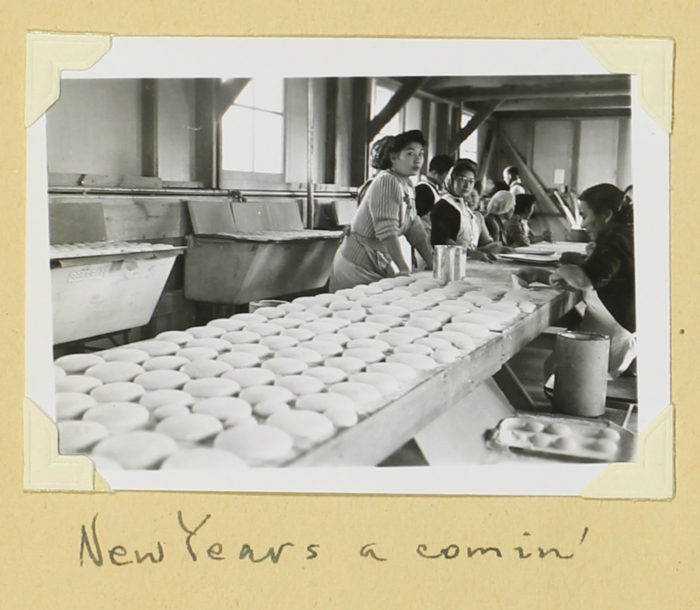
Japanese American National Museum, Gift of George Teruo Esaki (96.25.8)
Click to open full-size image in new tab.This object is part of the story New Year's A-Comin', which is about Community & Culture.
Look closely at this photograph and the handwritten text at the bottom.
- What do you see?
- What evidence in the photograph gives you clues about where this photograph may have been taken?
- Does this photograph convey to you that the New Year holiday is coming?
The individuals in this photograph are making mochi while incarcerated at Gila River, Arizona. Mochi is a Japanese rice cake made by steaming and pounding rice and then forming it into small round shapes, as seen in this photograph. Sticky in texture, it is a very traditional food made and eaten by Japanese families during the New Year holiday. Often families have large gatherings and work together all day making mochi. It is a custom that continues today in many Japanese and Japanese American families.

Japanese American National Museum, Gift of George Teruo Esaki (96.25.8)
Click to open full-size image in new tab.This object is part of the story New Year's A-Comin', which is about Community & Culture.
Look closely at this photograph.
- What do you see?
- Do you have any guesses about what is happening in this photograph?
- Is there anything you wonder about what is happening in this photograph?
This photograph was taken at Gila River and shows the part of the mochi-making process in which the rice is steamed in preparation for pounding.
- What do you notice about the people in this photograph?
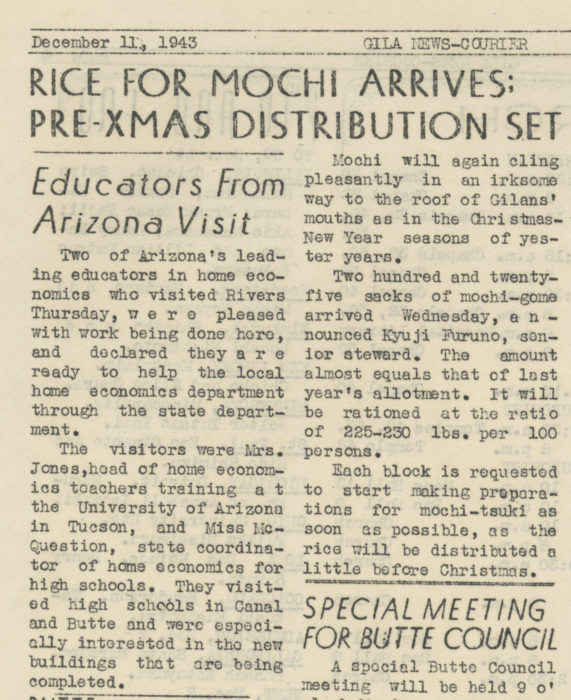
Japanese American National Museum, Gift of George Teruo Esaki (96.25.2)
Click to open full-size image in new tab.This object is part of the story New Year's A-Comin', which is about Community & Culture.
This is a page from the Gila News-Courier, the newspaper printed in the Gila River Concentration Camp in Arizona. Read the article titled “Rice for Mochi Arrives: Pre-Xmas Distribution Set” and consider the importance of this event to the incarcerated community at Gila River.
Here are some definitions that may be helpful as you read the article:
mochi-gome: sweet rice used to make mochi
mochi-tsuki: the making of mochi
Gilans: individuals living at Gila River
Mochi is associated with a happy time of year and mochi-making is an activity that brings Japanese American families and their communities together.
As you read the first sentence, ask yourself what types of feelings you think the Japanese and Japanese Americans associate with mochi.
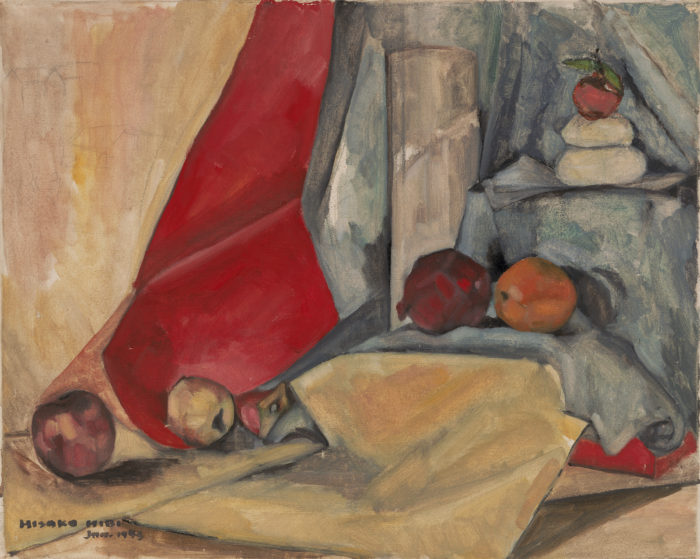
Hisako Hibi, Untitled (New Year’s Mochi), 1943, oil on canvas, Japanese American National Museum, Gift of Ibuki Hibi Lee (99.63.2)
Click to open full-size image in new tab.This object is part of the story New Year's A-Comin', which is about Community & Culture.
- Can you spot the mochi in this painting?
- What else do you see depicted?
- What would you say is the mood of this painting?
This painting was made by an artist named Hisako Hibi. During World War II, she was incarcerated in a concentration camp in Topaz, Utah, and it was there that she painted this image. The formation of two stacked mochi topped with a small citrus is called an okasane. It symbolizes hope for health and prosperity and is often displayed in homes during the New Year season.
- Why might painting a picture of an okasane be important to Hibi while she is in camp?
On the back of this painting is an inscription that reads:
Hisako Hibi. Jan 1943 at Topaz. Japanese without mochi (pounded sweet rice) is no New Year! It was very sad oshogatsu (New Year). So, I painted okazari mochi in the internment camp.
- Now that you know what is written on the back, does it change the mood of this painting for you? If so, how?
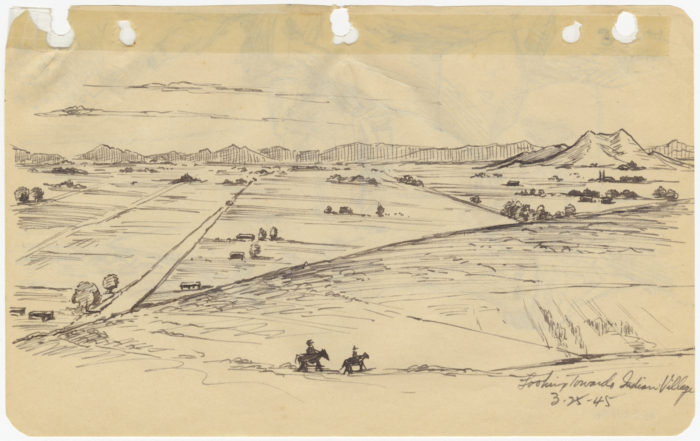
George Hoshida, Untitled (Looking Towards Indian Village 3-25-45), 1945, ink on paper, Japanese American National Museum, Gift of June Hoshida Honma, Sandra Hoshida, and Carole Hoshida Kanada (96.117.354)
Click to open full-size image in new tab.This object is part of the story Double Oppression, which is about Justice & Democracy.
Look closely at this drawing.
- What do you notice in the foreground, middle ground, and background?
- What kind of climate is depicted?
- Where do you think this drawing was made?
- When was this drawing made?
- What questions do you have about this drawing?
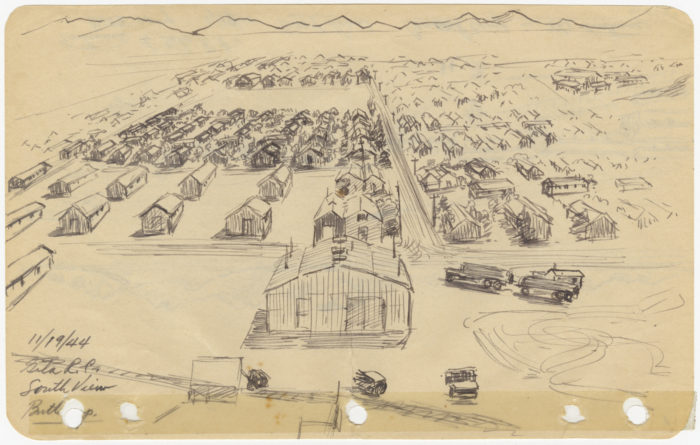
George Hoshida, Untitled (Entrance to Gila R. C. Butte Camp 11/19/44), 1944, ink on paper, Japanese American National Museum, Gift of June Hoshida Honma, Sandra Hoshida, and Carole Hoshida Kanada (96.117.350)
Click to open full-size image in new tab.This object is part of the story Double Oppression, which is about Justice & Democracy.
- What is the first thing you notice when you see this drawing?
- Who might live here?
- What kind of community could this be?
The Gila River War Relocation Center was one of the two Japanese American incarceration sites located on Native American reservations in the Sonora Desert in Arizona. The Bureau of Indian Affairs had jurisdiction over the Gila River and its 13,348 inmates. The land was leased by the Bureau of Indian Affairs from the Akimel O’otham (Pima) and Pee-Posh (Maricopa) Indians of the Gila River Indian Community. The summer temperatures were over 100 degrees and the barracks were poorly insulated; many inmates made swamp coolers to find relief from the heat.
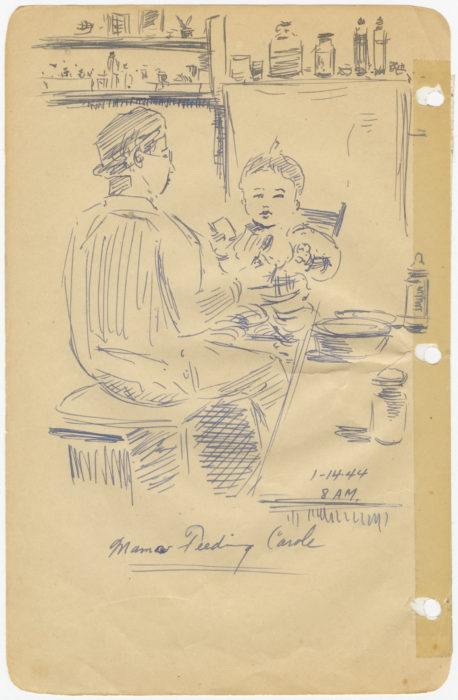
George Hoshida, Untitled (Mama Feeding Carole 1-14-44 8AM), 1944, ink on paper, Japanese American National Museum, Gift of June Hoshida Honma, Sandra Hoshida, and Carole Hoshida Kanada (96.117.345)
Click to open full-size image in new tab.This object is part of the story Double Oppression, which is about Justice & Democracy.
This is a drawing of the artist’s wife and young daughter.
- What is happening in this picture?
- What details are you most drawn to?
- Where could this scene have taken place?
This sketch captures a mother feeding a young child on a typical morning at the concentration camp in Gila River. Despite the circumstances of incarceration, parents tried to make life normal for their families. This included making do with the food served at the mess hall to feed to small children.
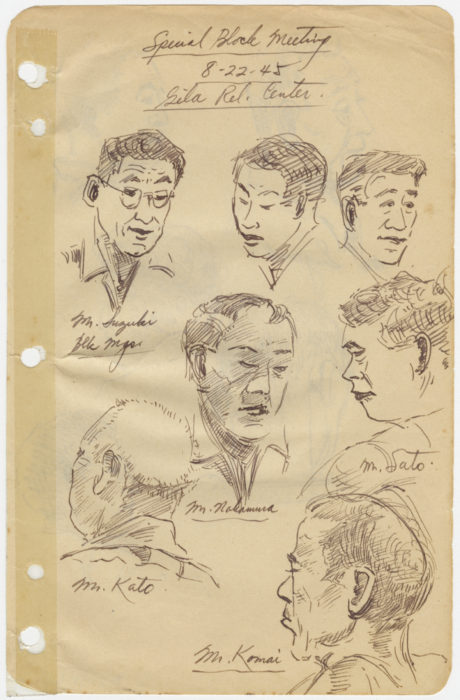
George Hoshida, Untitled (Special Block Meeting 8-22-45 Gila Rel. Center),1945, ink on paper, Japanese American National Museum, Gift of June Hoshida Honma, Sandra Hoshida, and Carole Hoshida Kanada (96.117.357)
Click to open full-size image in new tab.This object is part of the story Double Oppression, which is about Justice & Democracy.
- Have you ever sketched the people around you?
- Who might these people be?
- What do they have in common?
- What is different about all of them?
- At the top of the paper, the artist has written: “Special Block Meeting.” What do you think this special block meeting might be?
The Japanese Americans at each camp were separated by blocks and divided in the barracks by family. By the fall of 1942, despite this undemocratic situation, they organized themselves by electing representatives for temporary community councils. However, the War Relocation Authority imposed a rule that only US citizens could serve on these councils. This favored the American-born Nisei, many of whom were in their teens or early twenties, and not the actual community leaders. To circumvent this issue, each block democratically elected one block manager; those elected were often Japanese-speaking Issei or bilingual Kibei. The block managers were tasked with distributing supplies, handing out mail, and communicating the inmates’ concerns to the management.
